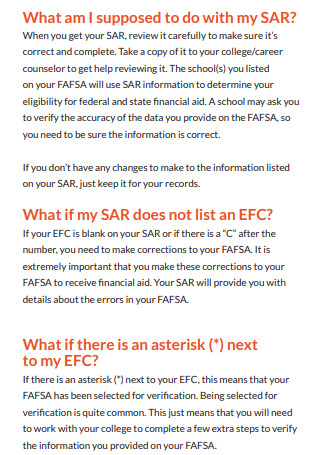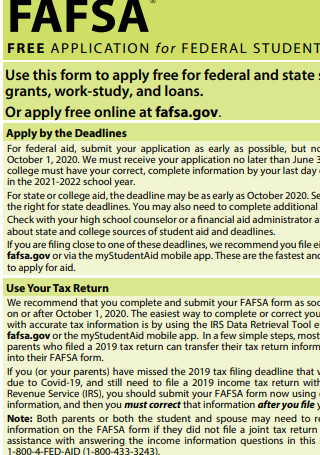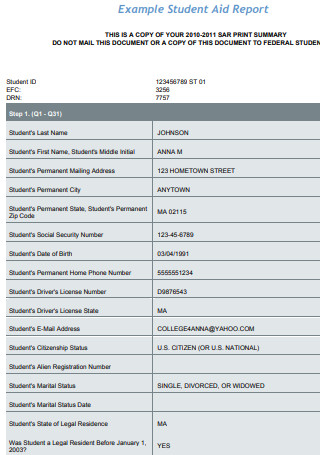20+ Student Aid Reports
-

Student Aid Report
download now -

English Student Aid Report
download now -

Example Student Aid Report
download now -

(SAR) Student Aid Report
download now -

Federal Student Aid
download now -

Student Aid Report Checklist
download now -

Student Aid Report (SAR) in PDF Format
download now -

Cares Act Student Aid Report
download now -

Student Aid Annual Report
download now -

Students Financial Aid Checklist
download now -

Federal Student Aid Report
download now -

Annual Student Financial Aid Report
download now -

Student Aid Report Flyer
download now -

Application for Federal Student Aid
download now -

Student Aid Report Facts
download now -

Financial Aid Board Report
download now -

Student Aid Report Instructions
download now -

CARES Act Student Aid Report
download now -

Example Student Aid Report
download now -

Financial Aid Report
download now
FREE Student Aid Report s to Download
20+ Student Aid Reports
What Is a Student Aid Report?
Important Concepts for Understanding Student Aid Reports
Sources of Financial Aid
Pros and Cons of Financial Student Aid
How to Create a Student Aid Report
FAQs
Are FAFSA and student aid report the same?
How do I read my SAR report?
Why is the Student Aid Report important?
What does the student aid report tell you?
What Is a Student Aid Report?
A student aid report or SAR is a document that states if an applicant is qualified and eligible to receive financial aid. The report also summarizes information based on an applicant’s FAFSA. A student aid report can either be a physical or an electronic copy.
According to a 2021 article published by digital media company U.S. News & World Report, many students take out loans to pay for college. Based on 2019 figures, 65% of graduates had borrowed student loans. The article further argues that government or federal student loans come with better protections when compared to private loans. One major advantage of a federal loan is interest rate. Typically, private loans come with higher interest rates versus federal loans.
Important Concepts for Understanding Student Aid Reports
To understand the inner workings of a student aid report, it is best to familiarize yourself with important concepts that will frequently come up in the report. Applying for student aid requires a general understanding of some key acronyms.
Sources of Financial Aid
Not all parents can afford to send their children to college. Especially these days when the cost of college is climbing even higher, covering even just the basic expenses can be a daily struggle. This goes beyond merely allocating an adequate college budget. Financial aid may be a catalyst for a better quality of life. The examples listed below are some common sources of student aid:
Pros and Cons of Financial Student Aid
“Free ride to college” is a phrase that, on the surface, is nice to hear. However, like most things, it still has its pros and cons. It’s only a matter of weighing each one in order to reach informed and educated decisions. The examples below are some pros and cons when it comes to financial student aid.
How to Create a Student Aid Report
A student aid report is typically generated online. Sample templates are also readily available above for your convenience. And whether you are an applicant, federal, or academic personnel, it’s essential to be acquainted with the different parts of a student aid report. Keep in mind the important steps below:
Step 1: Basic Info
A student aid report includes a title and the school year. Basic details such as the applicant’s full name and complete address, and the expected family contribution or EFC are clearly indicated on the form. Similar to a formal letter, the date should always be included. Some student aid reports also open with a salutation (e.g., Dear Student’s Name).
Step 2: Application Status
The application status basically informs the student whether or not the application was successful or not. This section contains comments or remarks not only regarding the student’s eligibility, but also about the schools they applied to. It may also state whether the applicant has completed or is lacking in his or her requirements, based on the FAFSA. For example, a student will be able to find out if she is eligible for the Pell Grant in the application status section of the report.
Step 3: FAFSA Information
Again, the student aid report or SAR is based on the FAFSA form submitted by the applicant. In the succeeding pages of a student aid report, the applicant’s information is inputted and summarized. The information can be pretty comprehensive and it covers several aspects such as personal and family contact details, marital status, dependents, social security and driver’s license numbers, net worth, and all other financial information.
Step 4: Next Steps
This section may either precede or come after the summary of FAFSA information. The applicant is duly informed of any next steps he or she must take. Students may be asked to review, modify, correct, or apply the necessary changes in their application. The federal student aid process is usually electronic, so the SAR may indicate instructions on how to log in or navigate the website in order view the status, make corrections, etc.
FAQs
Are FAFSA and student aid report the same?
A student needs to fill out a FAFSA in order to obtain a student aid report. The two documents are related but are not the same thing. A student aid report summarizes the information submitted on a FAFSA form.
How do I read my SAR report?
According to Forbes, you can view your student aid report online using your Federal Student Aid ID on FAFSA.gov. It is important to know the different terms and concepts that will appear on the report. Be sure you have a basic understanding of expected family contribution (EFC), data release number (DRN), cost of attendance (COA), and the verification selection process.
Why is the Student Aid Report important?
It is important that you provide accurate information on your FAFSA because it will greatly affect your student aid report. If you are applying for financial aid to go to college, the student aid report is essential because your eligibility is measured and based on what the report surmises. The financial aid benefits that colleges and universities give are directly related to the student aid report.
What does the student aid report tell you?
The student aid report informs you if you are eligible to receive financial aid. This is calculated and decided by the U.S. Department of Education when it generates your student aid report. You can obtain this report by filing a FAFSA (Free Application for Federal Student Aid). The student aid report contains key information including expected family contribution (EFC), data release number (DRN), application status, etc.
Despite the technicalities of a FAFSA or SAR form, it is a worthwhile shot especially when one’s education is on the line. In today’s fast-paced and hyper competitive economy, higher education should be made accessible and inclusive for all. Sadly, the current situation is far from ideal. So it goes without saying that financial aid can serve as a lifeline for a lot of deserving and eligible students. Browse a variety of student aid report templates above and download a sample now!
